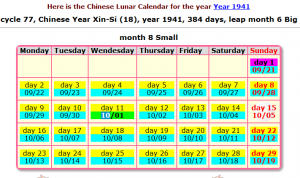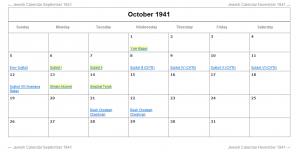In a perfect world, the lunar calendar and the solar calendar would be in synch. The cycles of the moon and the revolution of the earth around the sun would work together to create a single unified calendar by which we could mark all events. The fact that this is not the case is just one indication that the formation of our solar system was a random event, rather than a result of intelligent design. The mismatch in calendars, however, has spawned lots of mathematical calculations and has given philosophers and theologians much food for thought.
Early man went by the lunar calendar, because on a daily basis, and week by week, this calendar works best, but users of a lunar calendar were forced to make corrections, so that there would not be slippage from year to year for the major seasons, which are solar events. Because each culture made these corrections differently, there are several well known lunar calendars, the most famous of which are the Chinese Lunar Calendar and the Hebrew Lunar Calendar.
The calendar that most of the world goes by today is a solar calendar invented by the Romans, known as the Gregorian Calendar.
In order to see the variations in how the different calendars treat lunar events and solar events, let’s talk about the harvest moon, an annual occurrence that happens in the fall.
The harvest moon is the full moon that occurs “closest to the autumnal equinox”, according to the wikipedia. As such, this is an event that is defined both by the solar cycle and the lunar cycle. If the lunar and the solar calendars were totally in synch, then this event would occur on the same day of the year, no matter which calendar we were using.
This year, 2012, the Harvest Moon falls on September 29-30, according to earthsky.org. The “Harvest Moon” is so called, because in the days before artificial lights, farmers found that it was easiest to bring in the crops during the harvest moon, as there is no long dark period between sunset and moonrise during the full moon closest to the autumnal equinox.
The most famous song about the Harvest Moon is “Shine On Harvest Moon”
By Nora Bayes and Jack Norworth (1903).
Now, because the Gregorian calendar is a solar calendar, the Harvest moon in the Northern Hemisphere occurs in either September or October, but never on the same day, from year to year. On the other hand, when you use a lunar calendar, then the full moon always occurs on the 15th day of the month. Every four years the Harvest Moon occurs in October in the Northern Hemisphere according to the Gregorian Calendar. Quite a bit more rarely, the autumnal equinox and the Harvest Moon coincide, occurring during the same night. When this happens, it is called a Super Harvest Moon.
There are two lunar holidays I know of celebrated around the time of the harvest moon, each in a different lunar calendar and according to a different cultural tradition.

Mid-Autumn Festival Celebration in Beijing
Image Source: Wikipedia
The Chinese Mid-Autumn Festival ( 中秋節) celebrates an ancient legend involving the moon, and it falls on the 15th day of the eighth month of the Chinese Lunar Calendar. Because the lunar calendar and the Gregorian Calendar are not in synch, this is a different day in either September or October, by the western calendar, each year. Notice that it’s called Mid-Autumn Festival, implying that it celebrates the Autmnal Equinox, but it is not defined that way: it is defined by the full moon, so only on a Super Harvest Moon will Mid-Autumn Festival actually occur during the Autumnal Equinox. This year, 2012, Mid-Autumn Festival will occur on September the 30th. However, in 2013, it will fall on September 19, in 2014, on September 8, in 2015, on September 27, in 2016, on September 15, and in 2017 on October 4.
The holiday of Sukkoth, in Hebrew, סֻכּוֹת, is a celebration defined in the Old Testament, and it falls on the 15th day of the seventh month of the Hebrew calendar. During this holiday, people build huts in their yards and gather harvested fruit. It is a seven day event, but the first day falls on the full moon. This year, 2012, that is officially set as October 1st, according to the Wikipedia. But if you really understand how Hebrew holidays work, then you know that the holiday starts on the eve of the day before, and that this year that’s on the eve of September 30th: ערב סכות erev Sukkoth.
So… do Mid-Autumn Festival and Sukkoth occur on the same day? It’s very, very close. From a celestial event perspective, are these two holidays not really the same? And aren’t they supposed to occur during the Harvest Moon? What do you think? Do Mid-Autumn Festival and Sukkoth start on the same day of the lunar calendar? Do you think they celebrate different things? Or are they two slightly different cultures’ way of observing the same celestial event and the same season of harvest?
When I lived in Taiwan, and I witnessed some of the Mid-Autumn Festival celebrations, many things about the festivities did remind me of Sukkoth in Israel. I used this experience in writing my novel Our Lady of Kaifeng, which is set in China in 1941. When I was researching the story, I found out that in 1941, Mid-Autumn Festival and Sukkoth both fell on the same day of the Gregorian calendar: October 5th.
In Chapter 6, “Harvest Moon”, of Our Lady of Kaifeng, Marah Fallowfield is taken by Father Horvath to celebrate Sukkoth with the the Kaifeng Jews, but the ceremonies they conduct are not all that different from those being held by Chinese people throughout the city. When Marah realizes that the two holidays, Sukkoth and Mid-Autumn Festival, fall on the same day, she wonders why that is. Ted Sesame suggests that it might be because there is only one god. But Marah thinks it’s because there is only one moon. What do you think?
This year, whether you are celebrating the harvest moon, Mid-Autumn Festival, or Sukkoth, don’t forget to look up at the beautiful big, bright moon on the evening of September 29th and 3oth!

Our Lady of Kaifeng — Part One — Order Here

Our Lady of Kaifenv — Part Two — Order here
Related Links
http://eyeonlifemag.com/eye-on-writing/book-review-our-lady-of-kaifeng-by-aya-katz
http://sweetiepie.hubpages.com/hub/Book-Review-Our-Lady-of-Kaifeng
http://www.examiner.com/article/aya-katz-and-the-artwork-from-the-novel-our-lady-of-kaifeng






This is good background for understanding more about the harvest moon festivals in Our Lady of Kaifeng.
Thanks, Sweetbearies.